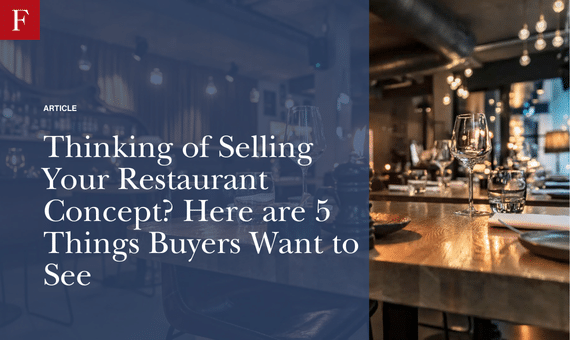
Thinking of Selling Your Restaurant Concept? Here are 5 Things Buyers Want to See
With sales projected to pass a record-breaking $1 trillion this year, the outlook is cautiously optimistic for the restaurant industry in 2024. This optimism extends to the M&A markets as well, where restaurants continue to attract buyer interest thanks to the industry’s adaptability, strength, and enduring appeal to consumers.
While optimism abounds in the restaurant industry, many owners feel less so when it comes to profitability. Average food costs have increased more than 20% and average wages more than 30% from 2019 – both of which obviously impact profitability and sustainability, but neither are so easy to pass along to guests. Restaurant owners are some of the nimblest businesspeople we know, and if anyone can overcome a challenge, it’s a restaurant operator. However, owners may be wise to consider their options as buyers continue to pursue restaurant opportunities.
Buyers conduct several types of due diligence – commercial, operational, financial, and legal – when evaluating a restaurant opportunity. While they look at many different factors, most of which are unique to the concept, there are several attributes buyers consistently look for in restaurant deals. Below are a handful, based on our experience working with these buyers.
Untapped Growth Potential
The restaurant owners and operators we work with have a proven concept: they have demonstrated the ability to be successful for a period of time. They almost always offer great food and consistently deliver value to their customers. The owners have built the foundation of the brand and have a vision for growth, but often lack the additional resources (e.g., capital and talent) to grow and scale.
As sell side advisors, we help owners surface untapped growth potential and underexploited assets. These growth opportunities are unique to the concept and are influenced by a variety of external forces (consumer trends, market conditions, regulatory environment) and internal factors (operational structure, systems, team). For a franchisor, it may be bringing on a site selection partner to identify prime franchisee locations and negotiate favorable lease terms. For others it could be investing in marketing to attract customers, or expanding services (delivery, catering) to boost revenue streams. Buyers seek out concepts where they can easily implement solutions to grow a brand. When an owner can clearly communicate available growth opportunities, it signals to buyers that there’s runway or low hanging fruit to be harvested.
Leadership and Team
Founders have a deep emotional connection to their businesses, and they operate with unrelenting passion. Yet this can often lead to Owner Syndrome – where a legacy founder tries to maintain the same level of control while also trying to grow the business, confusing a job with equity. Instead of growing into the primary role of being an owner, this founder has gotten lost working “in the business” instead of “working on the business.” Many times, they have taken on too many jobs: general manager, sales & marketing director, HR, and bookkeeper.
If a company relies too heavily on one person or a couple of key people, then scaling a brand can be extremely hard and extremely hard to sell at the proper valuation. Successful leaders build strong teams – teams that can replicate the tempo, vision, and passion of the founder (or founders). They create processes that can be performed by the next level of high-quality leaders and they set their people up for success. Founders that can delegate critical company tasks have greater time to focus on higher-value initiatives, which in turn can drive growth. This is attractive to buyers, as they want to acquire a company that can continue growing after an owner makes an exit.
Sales Growth Metrics
When we meet with owners, we dig into the company’s KPIs and how they compare to industry benchmarks. With franchisors we will first focus on key sales growth metrics: AUV or average unit volume; same-store sales growth; and franchise unit growth. These are important points of analysis for buyers and help determine management’s ability to generate revenue growth from existing stores and the potential of future stores.
Buyers want to see measurable increases in same-store sales growth. Why? If AUV growth is greater than same-store sales growth, it could be attributed to higher sales from new units compared to existing stores. This could signal flat performance by established stores and that there is limited potential for future revenue growth. Additionally, the number of units being added demonstrates a brand’s replicability. The addition of new stores across different geographic locations coupled with AUV growth shows a repeatable, in-demand concept. Conversely, a brand that has closed a number of locations is not fatal, but the reasons leading to the closures need to have been corrected.
Economics
Buyers look closely at a restaurant concept’s cash-on-cash return ratio or said differently “how long before I get my money back?” This is calculated as store-level EBITDA as a percentage of all-in costs (buildout and pre-opening expenses). For example, a new store requires $800,000 in buildout costs and is estimated to generate $2 million in annual sales. Assume a 20% margin to calculate store-level EBITDA of $400,000 and the cash-on-cash return would be 50%.
The cash-on-cash return ratio factors in several operational elements including a restaurant’s margins. An owner should have a firm grasp on the company’s food and labor costs and how those compare to industry standards. In the restaurant world, a general rule of thumb is 30% for food costs and 30% for labor, plus 20% for operating expenses – this comes out to a 20% margin. A brand with strong unit economics and an attractive cash-on-cash return ratio reflects to a buyer that store formats are efficient and effective.
Systems, Processes, and Culture
The restaurant world is built on systems and processes: cooking techniques, inventory management, food safety practices, quality control measures, and more. A restaurant that runs with well-developed operational systems, established financial controls, and documented best practices provides a strong foundation for growth and scale.
Systems and processes are only as strong as the people running them. More and more, we see buyers putting greater value on a company’s culture. Why? In an industry that has so many labor challenges, a brand with a strong culture helps attract workers and drives greater employee engagement and retention. Take the example of Raising Cane’s, a chain with positive same-store sales for the past 15 years. The company’s astronomical success is underpinned by its culture, which prioritizes employee well-being along with leadership development (its Restaurant Partner program provides a pathway for managers to become operators).
Conclusion
Restaurant owners considering next steps with their concept can benefit from advisors with deep industry expertise, specifically advisors with both operational experience and an M&A background. An M&A advisor with restaurant expertise understands market dynamics, operating systems and processes, and industry-specific KPIs – and can speak to the opportunity from a seller’s perspective and through the lens of a potential buyer.
Download the article here.














